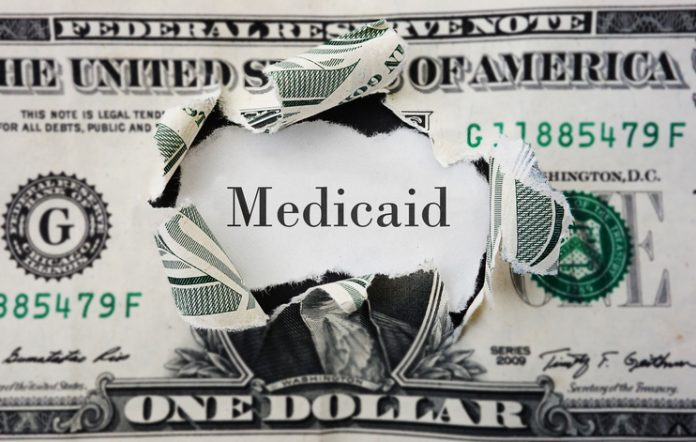Health Care Coverage Squeeze
Private insurance plans are being crowded out of the market as subsidized government programs scoop up growing numbers of enrollees.
Citing data released in September by the U.S. Census Bureau, the Washington, D.C.-based Committee to Unleash Prosperity reported the number of people covered by private insurance plans declined by 1.2 million from 2020 to 2021, the population enrolled in Medicaid rose by 3.2 million, and the number of Medicare recipients increased by 1.7 million.
“In 2021, private health insurance continued to be more prevalent than public coverage, at 66.0% and 35.7%, respectively,” the Census Bureau reported.
The Affordable Care Act’s (ACA) expansion of Medicaid, the Biden administration’s elimination of almost all work requirements for Medicaid recipients, and the Inflation Reduction Act’s extension of increased subsidies for insurance premiums on the Obamacare exchanges have combined to move millions of people into government-provided health insurance.
Workplace Dropouts
If current trends continue, increasing numbers of Americans will be enrolled in government insurance plans. That may be detrimental to those who have swelled the Medicaid rolls in recent years, according to the Buckeye Institute. The organization’s research shows separating Medicaid recipients from work radically reduces their earning potential.
“Medicaid expansion has had the unintended consequence of causing healthy, single adults to leave the labor force or reduce their work hours to maintain or qualify for Medicaid benefits,” said Rea S. Hederman Jr. in a statement issued upon release of the 2018 Buckeye Institute study “Healthy and Working: Benefits of Work Requirements for Medicaid Recipients.” Hederman is vice president of policy for the institute and executive director of its Economic Research Center. “And by exiting the workforce, workers have risked reducing their lifetime earnings,” Hederman said.
Four years before the Biden administration all but eliminated work requirements for Medicaid recipients, the Buckeye Institute found implementing such requirements can increase total lifetime earnings to close to $1 million for individuals who transition off Medicaid.
Wealth-Building Work
Work requirements can increase a recipient’s lifetime earnings by more than $212,000 for women and more than $323,000 for men who remain on Medicaid for their entire working life, and it can increase weekly work time by 22 hours for women (from 12 hours to 34 hours per week) and by 25 hours for men (from 13 hours to 38 hours per week), the study found.
“Government insurance often replaces or crowds out private insurance,” Hederman told Health Care News. “During the COVID crisis, Medicaid enrollment has spiked, and people have remained on government health insurance even as they have returned to work. The federal government has restricted the ability of states to audit Medicaid programs to remove ineligible recipients.
“Taxpayer-funded insurance programs have replaced private insurance as federal programs are highly subsidizing insurance for millions of Americans,” Hederman said.
The Biden administration’s elimination of work requirements has contributed to the current labor shortage by reducing incentives for low-income people to seek employment.
Medicaid Boom
As Medicaid expansion under the ACA took its toll on private insurance plans, two provisions of the law aimed at increasing the availability of employer-sponsored health insurance (ESI) among workers at small firms missed their mark, according to a November 2021 study published in the Southern Economic Journal.
Study author Conor Lennon, an associate professor of economics at Rensselaer Polytechnic Institute, compared changes in ESI availability among workers at small and large firms before and after the ACA came into effect in 2013. Lennon’s review of Medical Expenditure Panel Survey data found a slight increase in ESI availability and a big increase in working adults being covered by Medicaid.
“I find no evidence that greater ESI availability led to increases in ESI coverage rates,” Lennon wrote. “Instead, descriptive estimates suggest that gains in health insurance coverage after 2013 consist of significant increases in the number of working adults who report having Medicaid coverage, including among workers who are offered ESI.”
Lennon found “limited evidence to suggest that the ACA’s provisions improved access to care or measures of health status for workers.”
Government Dominance
Brian Blase, Ph.D., president of the Paragon Health Institute, says the government’s ever-increasing role in health care will place an undue burden on taxpayers.
“The majority of money that health insurers now receive comes from government as opposed to people paying for private coverage,” Blase said. “With Congress enacting policies to dramatically expand Obamacare subsidies and substantially grow Medicaid managed care, private spending and coverage are being replaced by government spending and coverage. Although these policies have boosted profits for big health insurance companies, they have resulted in an explosion of taxpayer cost and poured fuel on the nation’s inflationary fire.”
Government money is corrupting the private sector, says Doug Badger, a senior analyst for health and welfare policy at The Heritage Foundation.
“Private insurance companies are becoming increasingly reliant on government payments to fatten their bottom lines,” said Badger.
“Since Obamacare, companies selling individual policies have begun to operate like government-funded enterprises, with premium subsidies accounting for nearly 75 percent of their revenue,” said Badger. “States contract with low-bid HMOs to cover most of their Medicaid receipts. Medicaid HMOs collected $154 billion from the government during the second quarter of this year alone. Apart from the group markets, taxpayers are making the health insurance industry profitable.”
Bonner Russell Cohen, Ph.D., (bcohen@nationalcenter.org) is a senior fellow at the National Center for Public Policy Research.
Internet Info:
Rea S. Hederman Jr. et al., “Healthy and Working: Benefits of Work Requirements for Medicaid Recipients,” The Buckeye Institute, December 3, 2018: https://www.buckeyeinstitute.org/library/docLib/2018-12-03-Healthy-Working-Benefits-of-Work-Requirements-for-Medicaid-Recipients-policy-report.pdf
For more great content from Health Care News.





















